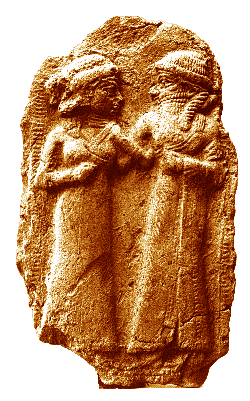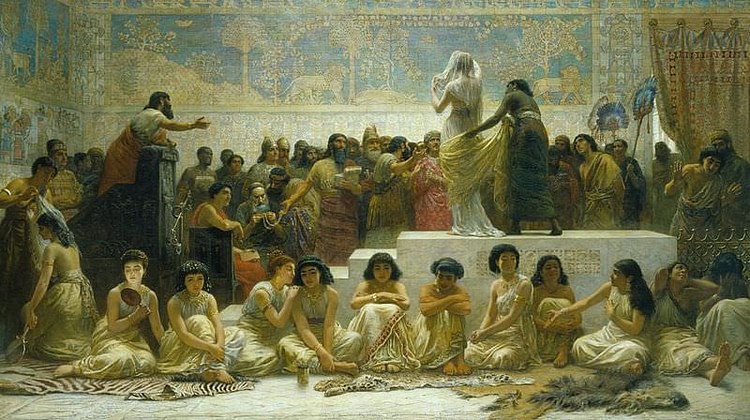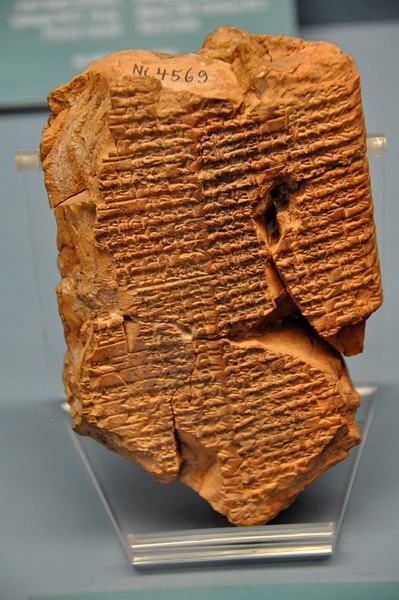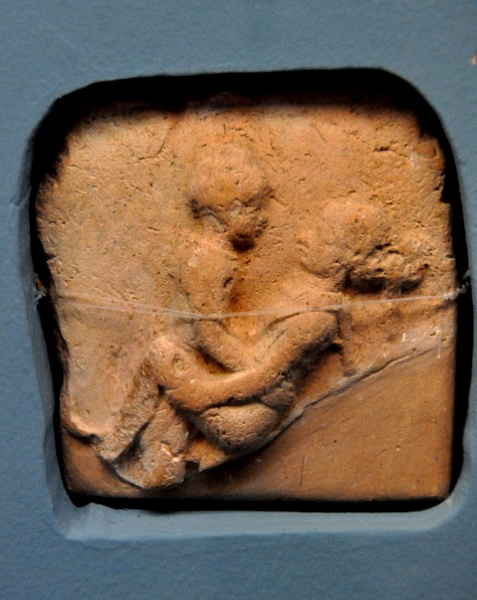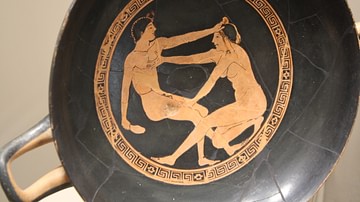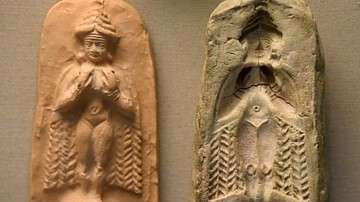Medical texts from ancient Mesopotamia provide prescriptions and practices for curing all manner of ailments, wounds, and diseases. There was one malady, however, which had no cure: passionate love. From a medical text found in the Library of Ashurbanipal at Nineveh comes this passage:
When the patient is continually clearing his throat; is often lost for words; is always talking to himself when he is quite alone, and laughing for no reason in the corners of fields, is habitually depressed, his throat tight, finds no pleasure in eating or drinking, endlessly repeating, with great sighs, 'Ah, my poor heart!' – he is suffering from lovesickness. For a man and for a woman, it is all one and the same. (Bottéro, 102-103)
Marriage in ancient Mesopotamia was of vital importance to the society, literally, because it ensured the continuation of the family line and provided social stability. Arranged marriages were the norm, in which the couple had often never met, and – according to Herodotus – there were even bridal auctions where women were sold to the highest bidder, but human relationships in ancient Mesopotamia were just as complex and layered as those today and part of that complexity was the emotion of love. The historian Karen Nemet-Nejat notes, "Like people the world over and throughout time, ancient Mesopotamians fell deeply in love" (132).
The popularity of what, today, would be called 'love songs' also attests to the commonality of deep romantic attachment between couples. A few of the titles of these poems illustrate this:
'Sleep, begone! I want to hold my darling in my arms!'
When you speak to me, you make my heart swell till I could die!'
'I did not close my eyes last night; Yes, I was awake all night long, my darling [thinking of you].'
(Bottéro, 106)
There are also poems, such as an Akkadian composition from c. 1750 BCE, which depicts two lovers arguing because the woman feels the man is attracted to another and he must convince her that she is the only one for him. In the end, after they have discussed the problem, the couple reconciles and it is made clear that they will now live happily ever after together.
The Business of Marriage
Contrasted with romantic love and a couple sharing their lives together, however, is the 'business side' of marriage and sex. Herodotus reports that every woman, at least once in her lifetime, had to sit outside the temple of Ishtar (Inanna) and agree to have sex with whatever stranger chose her. This custom was thought to ensure the fertility and continued prosperity of the community. As a woman's virginity was considered requisite for a marriage, it would seem unlikely that unmarried women would have taken part in this, and yet Herodotus states that 'every woman' was required to. The practice of sacred prostitution, as Herodotus describes it, has been challenged by many modern-day scholars, but his description of the bride auction has not. Herodotus writes:
Once a year in each village the young women eligible to marry were collected all together in one place; while the men stood around them in a circle. Then a herald called up the young women one by one and offered them for sale. He began with the most beautiful. When she was sold for a high price, he offered for sale the one who ranked next in beauty. All of them were then sold to be wives. The richest of the Babylonians who wished to wed bid against each other for the loveliest young women, while the commoners, who were not concerned about beauty, received the uglier women along with monetary compensation…All who liked might come, even from distant villages, and bid for the women. This was the best of all their customs but it has now fallen into disuse.
(Histories I: 196)
So while romantic love did play a part in Mesopotamian marriages, it is true that, according to the customs and expectations of Mesopotamian society, marriage was a legal contract between the father of a girl and another man (the groom, as in the case of the bride auction where the groom paid the girl's father the brideprice) or, more commonly, between two families, which functioned as the foundation of a community. Scholar Stephen Bertman comments:
In the language of the Sumerians, the word for `love' was a compound verb that, in its literal sense, meant `to measure the earth,' that is, `to mark off land'. Among both the Sumerians and the Babylonians (and very likely among the Assyrians as well) marriage was fundamentally a business arrangement designed to assure and perpetuate an orderly society. Though there was an inevitable emotional component to marriage, its prime intent in the eyes of the state was not companionship but procreation; not personal happiness in the present but communal continuity for the future. (275-276)
This was, no doubt, the 'official' view of marriage, and there is no evidence to suggest that a man and woman decided to simply get married on their own (although there is evidence of a couple living together without marrying). Bertman writes:
Every marriage began with a legal contract. Indeed, as Mesopotamian law stated, if a man should marry without having first drawn up and executed a marriage contract, the woman he `marries' would not be his wife…every marriage began not with a joint decision by two people in love but with a negotiation between representatives of two families. (276)
Once the marriage contract was signed in the presence of witnesses, the ceremony could be planned. The wedding ceremony had to include a feast in order to be considered legitimate. The course of the marriage process had five stages which needed to be observed in order for the couple to be legally married:
- Engagement/marriage contract
- Payment of the families of the bride and groom to each other (the dowry and bride price)
- The ceremony/feast
- The bride moving to her father-in-law's home
- Sexual intercourse between the couple, with the bride expected to be a virgin on her wedding night and to become pregnant
If any one of these steps was not performed, or not performed properly (such as the bride not becoming pregnant), the marriage could be invalidated. In the event the bride turned out not to be a virgin, or could not conceive, the groom could return her to her family. He would have to return her dowry to her family but would get back the bride price his family had paid.
The Engagement
Special attention was paid to the engagement. Bertman notes:
Engagements were serious business in Babylonia, especially for those who might have a change of heart. According to Hammurabi's Code, a suitor who changed his mind would forfeit his entire deposit (betrothal gift) and bride-price. If the prospective father-in-law changed his mind, he had to pay the disappointed suitor double the bride-price. Futhermore, if a rival suitor persuaded the father-in-law to change his mind, not only did the father-in-law have to pay double, but the rival wasn't allowed to marry the daughter. These legal penalties acted as a potent deterrent against changes of heart and a powerful incentive for both responsible decision making and orderly social behavior. (276)
These incentives and penalties were particularly important because young people in Mesopotamia, as young people in the present day, did not always wish to comply with their parents' wishes. A young man or woman might well love someone other than the 'best match' chosen by their parents. A poem featuring the goddess Inanna, known for her penchant for 'free love' and doing as she pleased, and her lover Dumuzi, is thought to illustrate the problems parents had in guiding their children, daughters in particular, in proper conduct resulting in a happy marriage (although, as Inanna and Dumuzi were a very popular couple in religious and secular Mesopotamian literature, it is doubtful that young people interpreted the poem in the same way their parents may have). The scholar Jean Bottéro describes the work, pointing out how Inanna was encouraged to marry the successful farmer god Enkimdu but loved the shepherd god Dumuzi and so chose him. Bottéro elaborates:
She furtively left the house, like an amorous teenager, to go to meet her beloved beneath the stars, 'which sparkled as she did', then to dally beneath his caresses and suddenly wonder, seeing the night advance, how she was going to explain her absence and lateness to her mother: 'Let me go! I must go home! Let me go, Dumuzi! I must go in! /What lie shall I tell my mother? /What lie shall I tell my mother Ningal?' And Dumuzi suggests an answer: she will say that her girl companions persuaded her to go with them to listen to music and dance. (109)
The penalties and incentives, then, were supposed to keep a young couple on the desired path toward marriage and prevent them from engaging in romances under the stars. Once the couple was properly married, they were expected to produce children quickly. Sex was considered just another aspect of one's life, and there was none of the modern-day embarrassment, shyness, or taboo involved in Mesopotamians' sex lives. Regarding LGBTQ+ in the ancient world, Bottéro states that "Homosexual love could be enjoyed" without fear of social stigma, and texts mention men "preferring to take the female role" in sex. Further, he writes, "Various unusual positions could be adopted: 'standing'; 'on a chair'; 'across the bed or the partner'; 'taking her from behind' or even 'sodomising her', and sodomy, defined as anal intercourse, was a common form of contraceptive (101). He further notes:
it could happen that an eccentric setting was chosen…instead of keeping to your favourite place, the bedroom. You might take it into your head to 'make love on the roof-terrace of the house'; or 'on the threshold of the door'; or 'right in the middle of a field or orchard', or 'in some deserted place'; or 'a no through road'; or even `in the middle of the street', either with just any woman on whom you had 'pounced' or with a prostitute. (Bottéro, 100)
Bottéro further points out:
Making love was a natural activity, as culturally ennobled as food was elevated by cuisine. Why on earth should one feel demeaned or diminished, or guilty in the eyes of the gods, practicing it in whatever way one pleased, always provided that no third party was harmed or that one was not infringing any of the customary prohibitions which controlled daily life. (97)
This is not to say that Mesopotamians never had affairs or were never unfaithful to their spouses. There is plenty of textual evidence which shows that they did and they were. However, as Bottéro notes, "When discovered, these crimes were severely punished by the judges, including the use of the death penalty: those of men in so far as they did serious wrong to a third party; those of women because, even when secret, they could harm the cohesion of the family" (93). Bottéro continues:
In Mesopotamia, amorous impulses and capabilities had traditionally been channeled by collective constraints with the aim of ensuring the security of what was held to be the very nucleus of the social body – the family – and thus to provide for its continuity. The fundamental vocation of every man and woman, his or her `destiny', as they said, referring matters to a radical wish on the part of the gods, was therefore marriage. And [as it is written in an ancient text] `the young man who has stayed solitary…having taken no wife, or raised children, and the young woman who has not been either deflowered, or impregnated, and of whom no husband has undone the clasp of her garment and put aside her robe, to embrace her and make her enjoy pleasure, until her breasts swell with milk and she has become a mother' were looked upon as marginal, doomed to languish in an unhappy existence. (92)
Procreation as the Goal of Marriage
Children were the natural and greatly desired consequence of marriage. Childlessness was considered a great misfortune, and a man could take a second wife if the bride proved infertile. Bottéro writes:
Once settled in her new status, all the jurisprudence shows us the wife entirely under the authority of her husband, and social constraints – giving the husband free rein – were not kind to her. In the first place, although monogamy was common, every man – according to his whims, needs, and resources – could add one or more 'second wives', or rather, concubines, to the first wife. (115)
The first wife was often consulted in choosing the second wives, and it was her responsibility to make sure they fulfilled the duties for which they had been chosen. If a concubine had been added to the home because the first wife could not have children, the concubine's offspring would become the children of the first wife and would be able to inherit and carry on the family name.
As the primary purpose of marriage, as far as society was concerned, was to produce children, a man could add as many concubines to his home as he could afford. The continuation of the family line was most important and so concubines were fairly common in cases where the wife was ill, in generally poor health, or infertile.
A man could not divorce his wife because of her state of health, however; he would continue to honor her as the first wife until she died. Under these circumstances, the concubine would become the first wife upon the wife's death, and if there were other women in the house, they would each move up one position in the home's hierarchy.
Divorce & Infidelity
Divorce carried a serious social stigma and was not common. Most people married for life, even if that marriage was not a happy one. Inscriptions record women running away from their husbands to sleep with other men. If caught in the act, the woman could be thrown into the river to drown, along with her lover, or could be impaled; both parties had to be spared or executed. The Code of Hammurabi states, "If, however, the owner of the wife wishes to keep her alive, the king will equally pardon the woman's lover."
Divorce was commonly initiated by the husband, but wives were allowed to divorce their mates if there was evidence of abuse or neglect. A husband could divorce his wife if she proved to be infertile, but, as he would then have to return her dowry, he was more likely to add a concubine to the family. It never seems to have occurred to the people of the time that the male could be to blame for a childless marriage; the fault was always ascribed to the woman. A husband could also divorce his wife on grounds of adultery or neglect of the home but, again, would have to return her property and also suffer the stigma of divorce. Both parties seem to have commonly chosen to make the best of the situation even if it was not optimal. Bottéro writes:
As for the married woman, provided she had a little 'guts' and knew how to make use of her charms, employing all her guile, she was no less capable of making her husband toe the line. A divinatory oracle mentions a woman made pregnant by a third party who ceaselessly implores the goddess of love, Ishtar, repeating: `Please let the child look like my husband!' [and] we are told of women who left their home and husband to go gallivanting not just once, but two, three…as many as eight times, some returning later, crestfallen, or never coming back at all. (120)
Women abandoning their families was uncommon but happened enough to have been written about. A woman traveling alone to another region or city to begin a new life, unless she was a prostitute, was rare but did occur and seems to have been an option taken by women who found themselves in an unhappy marriage and chose not to suffer the disgrace of a public divorce.
Since divorce favored the man, "if a woman expressed the desire to divorce, she could be thrown out of her husband's home penniless and naked" (Nemet-Nejat, 140). The man was the head of the household and the supreme authority, and a woman had to prove conclusively that her husband had failed to uphold his end of the marriage contract in order to obtain a divorce.
Even so, it should be noted that a majority of the myths of ancient Mesopotamia, especially the most popular myths (such as The Descent of Inanna, Inanna and the Huluppu Tree, Ereshkigal and Nergal) portray women in a very flattering light and, often, as having an advantage over men. While males were recognized as the authority in both government and in the home, women could own their own land and businesses, buy and sell slaves, and initiate divorce proceedings.
Bottéro cites evidence (such as the myths mentioned above and business contracts) that show women in Sumer enjoying greater freedoms than women after the rise of the Akkadian Empire (c. 2334 BCE). After the influence of Akkad, he writes, "if women in ancient Mesopotamia, even though regarded at all levels as inferior to men and treated as such, nevertheless seem to have enjoyed also consideration, rights, and freedoms, it is perhaps one of the distant results and vestiges of the old and mysterious Sumerian culture" (126). This culture remained prevalent enough, throughout the history of Mesopotamia, to allow a woman the freedom to escape from an unhappy home life and travel to another city or region to begin a new one.
Living Happily Ever After
Throughout all of the difficulties and legalities of marriage in Mesopotamia, however, then as now, there were many happy couples who lived together for life and enjoyed their children and grandchildren. In addition to the love poems mentioned above, letters, inscriptions, Mesopotamian art, paintings, and sculpture attest to genuine affection between couples, no matter how their marriage may have been arranged. The letters between Zimri-Lim, King of Mari, and his wife Shiptu, are especially touching in that it is clear how much they cared for, trusted, and relied on each other. Nemet-Nejat writes, "Happy marriages flourished in ancient times; a Sumerian proverb mentions a husband boasting that his wife had borne him eight sons and was still ready to make love" (132), and Bertman describes a Sumerian statue of a seated couple, from 2700 BCE, thusly:
An elderly Sumerian couple sit side by side fused by sculpture into a single piece of gypsum rock; his right arm wrapped around her shoulder, his left hand tenderly clasping her right, their large eyes looking straight ahead to the future, their aged hearts remembering the past. (280)
Although the customs of the Mesopotamians may seem strange, or even cruel, to a modern-day Western mind, the people of the ancient world were no different from those living today. Many modern marriages, begun with great promise, end badly, while many others, which initially struggle, endure for a lifetime. The practices that begin such unions are not as important as what the individuals involved make of their time together, and, in Mesopotamia as in the present, marriage presented many challenges that a couple either overcame or succumbed to.
